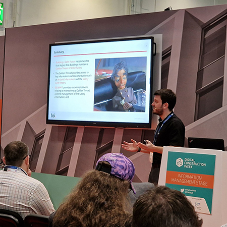During UKCW Birmingham 2022 Barbour ABI’s own Peter Chesters, alongside Tom Reynolds of the Bathroom Manufacturers Association and Paul Ranbo-West of Kelda Showers, gave a talk on sustainability in water infrastructure in the UK.
The main takeaway from the talk was that the UK may be sleepwalking into a water deficit issue, with current projections predicting a structural deficit by 2050. There are a number of reasons for why this has happened.
Of course, climate change. It is impossible to ignore climate change when talking about water infrastructure, as changing weather is meaning that rain is now falling in different places and in different quantities. Some reservoirs may not receive as much rain anymore thanks to drawing a bad hand in the geographical lottery.
Another factor is the lack of investment in water infrastructure. Tom Reynolds said, It is predicted that in order to meet demand, the UK will need to construct 30 new reservoirs over the next 30 years. In the last 30 years there has only been one new reservoir constructed.
While there is hardly any investment into new water projects, the current infrastructure that the UK has is crumbling. Leakage has become a major issue. According to this Guardian article, Ofwat reported leakages resulting in a loss of 2,923.8 megalitres of water a day from 2021-22 . This is a small improvement from the year prior, where losses through leakage of around 3,112.7 megalitres a day
but progress is currently happening at a glacial pace.
The priority for major water infrastructure projects, according to AMA Research’s ‘Pipes and Fittings Market Report’
, is dealing with wastewater overflow. This is also an important investment to be made as the AMA Report states:
“most of Britain’s urban wastewater systems were built in the nineteenth century to serve far smaller populations. Many are now operating at capacity and often exceeding it which has led to water companies dumping untreated sewage into rivers and the sea.”
There is no denying that this kind of infrastructure investment is necessary. However, investment into water catchment is equally as vital.
Of course, there are things people can, and should, be doing at home as well to help with water usage. The impacts of water usage from households is considerably smaller but we should still also work to improve this. There are basic pieces of maintenance work that can be done to mitigate leakages from your own household.
As Tom Reynolds stated, a huge contributor to leakages from households are toilet cisterns. The most common cause of this kind of leakage is a faulty rubber seal. These can be replaced quickly and cheaply. There is, in fact, a campaign from the bathroom-association called ‘Get Lavvy Savvy’ which aims to teach people about this and other similar bits of maintenance you can perform to reduce your own personal water consumption. In line with the goal stated by Sir James Bevan, head of the UK’s Environment Agency, to reduce each persons personal consumption: The current average per person per day is 148L, while the goal we should all be aiming for is 110L.
To find out more about the ‘Get Lavvy Savvy’ campaign you can click this link: https://bathroom-association.org.uk/getlavvysavvy/















